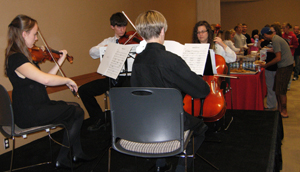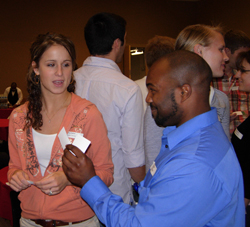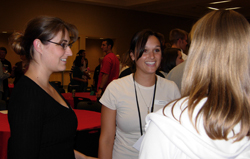 |
Celloist Aviva Segall, music director and principal conductor for the Omaha Area Youth Orchestras, was joined by Erik Thorstensen (viola), a senior at Burke High School, Lydia Selzle (violin), a senior at Millard North High School and Tim Grady (violin), a junior at Millard North. This marks the 50th anniversary of the Omaha Area Youth Orchestras. |
But, over pizza and Handel, students in UNMC’s School of Allied Health Professions found parallels between those who provide excellent health care and those who play beautiful music.
More than 250 first- and second-year allied health students attended the first “Dean’s Welcome” on Sept. 10 in the Truhlsen Event Center in the Michael F. Sorrell Center for Health Science Education.
 |
Clinical perfusion student Rico Lewis exchanges descriptive cards with physical therapy student Jenny Rother. |
 |
Physician assistant students Michaela Collins, left, and Amanda Bonds, center, search for cards. |
“Allied health professionals are increasingly being acknowledged for the important role they play,” College of Medicine Dean John Gollan, M.D., Ph.D., told the students. “Health care delivery is becoming more and more about teamwork and the integration of the various team members in the delivery of care to patients.”
Dr. Gollan also encouraged students to interact with students outside their respective fields of study.
“It’s easy to cluster with the people you know, but this is an opportunity to meet new friends and learn about different disciplines,” he said.
And they did.
Students walked through the doors in comfortable clusters, then sighed when they learned they had been assigned tables.
“Oh, we have to sit by people we don’t know,” said one student.
“We better be at the same table … noooo, none of us are.”
Along with their assigned seat, each student received two cards with such descriptive words as “New Orleans,” “musical,” “cytotechnologist” and “organizer.” Their task: search the crowd for two new cards that most represented them.
Clinical perfusion student Rico Lewis met new faces while he exchanged his cards for “clinical perfusion” and “New Orleans.”
Physical therapy student Josh tenBensel searched for someone, anyone, to take “connected” out of his hands.
The activity led second-year radiography student Lauri Patterson of Fremont, Neb., to meet students she generally doesn’t encounter in her day-to-day radiation science courses.
“When I came, there were only 12 people I knew,” she said.
|
|
Celloist Aviva Segall, music director and principal conductor for the Omaha Area Youth Orchestras for the past 10 years, gave the event’s keynote address on the importance of teamwork in the orchestra and how it parallels teamwork in the health care arena.
There are four elements of successful musical collaboration, Segal said:
- Shared goals — Individual techniques are rehearsed alone, she said, but the difference between sound and music lies in the ensemble working together as one on rhythm and dynamics.
- Clear roles and responsibilities — One person may take the lead, but shared leadership and clarity of roles is important. “Very few musicians are soloists,” she said.
- Communication — Listening to one another. When that doesn’t happen, basic instructions can be lost.
- Respect — Successful collaboration relies on respect for what each member brings to the team or ensemble.
Physical therapy student Brant Loose of Mitchell, Neb., understood the connections.
“No matter what your position in medicine or music you have to have communication to work properly together,” he said. “You must work together to be successful.”
tenBensel agreed. The greater the communication, he said, the better health care professionals work as a team and help people.
That, Segall said, is music to her ears.